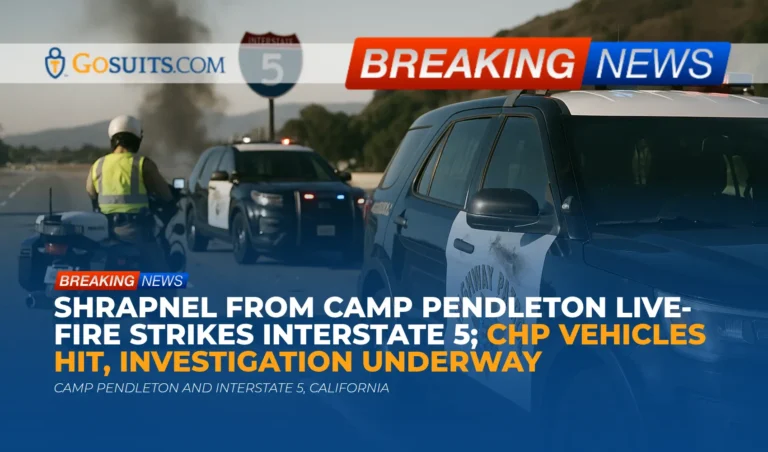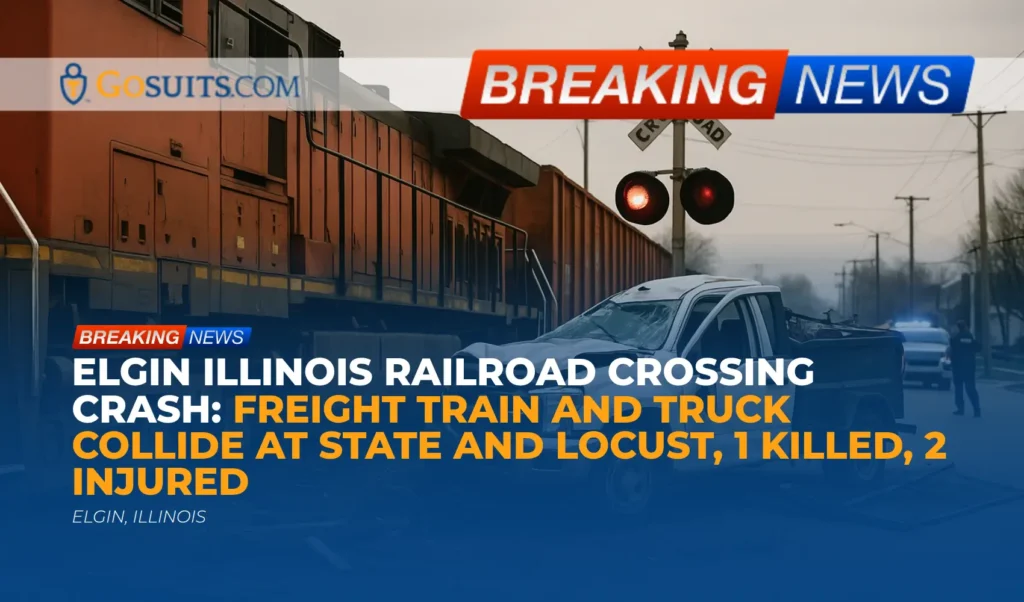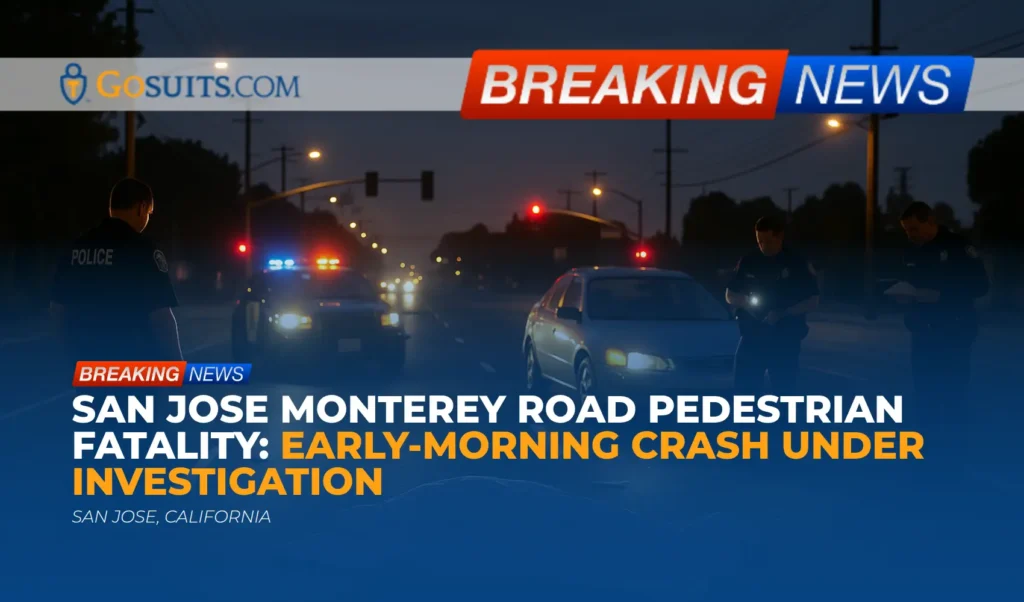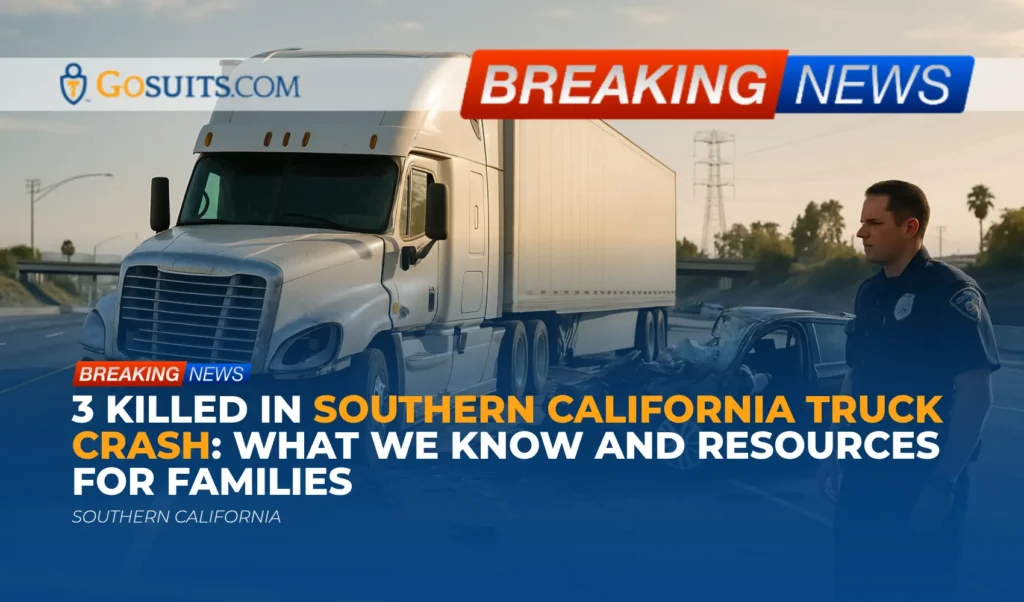- Overview of the reported incident at Camp Pendleton and Interstate 5
- What happened, when, and where
- What officials have said so far
- Safety considerations of live-fire demonstrations near public roadways
- Potential legal pathways after debris or munitions-related harm
- Evidence and documentation to preserve right away
- How to request police, roadway, and government records
- Insurance considerations and cautions about recorded statements
- Practical next steps for those affected
- Commentary from Gosuits Camp Pendleton, California Personal Injury Attorney
- Why prompt action matters after highway debris or explosives-related incidents
Overview of the reported incident at Camp Pendleton and Interstate 5
Reports indicate that during a live-fire rehearsal connected to a large-scale amphibious demonstration at Marine Corps Base Camp Pendleton, a 155mm artillery round may have detonated prematurely in the air outside the designated impact area, with shrapnel falling onto Interstate 5. California Highway Patrol personnel reported debris striking a CHP patrol car and motorcycle, including a two-inch fragment that left a dent in a vehicle. Firing operations were suspended shortly after the concern was raised. An investigation by the Marine Corps is underway.
Interstate 5 is a major coastal corridor running between Los Angeles and San Diego. State officials arranged a full closure of a significant stretch of the freeway during the event window due to safety concerns and the potential for driver distraction from explosive sounds. The situation is developing, and new facts may emerge as the investigation proceeds.
What happened, when, and where
When and where
The reported incident occurred in connection with a live-fire event at Marine Corps Base Camp Pendleton in northern San Diego County, with artillery firing over the coastal area adjacent to Interstate 5. State authorities ordered a time-limited closure of approximately 17 miles of the freeway during the demonstration.
What is reported to have occurred
Law enforcement on scene reported airborne detonation of a 155mm round outside the designated impact area, followed by shrapnel raining down onto the freeway. Debris reportedly impacted a CHP car and motorcycle and landed nearby on the roadway surface. At the time of writing, public reporting has focused on property damage, and any further information about injuries or additional damage has not been confirmed through public records available to us.
Who was involved
The event involved Marine Corps artillery units participating in the amphibious capabilities demonstration at Camp Pendleton. California Highway Patrol personnel were on scene in support of the freeway closure and responded to the shrapnel report. State-level officials coordinated the temporary closure of Interstate 5.
What officials have said so far
Public statements indicate that the Marine Corps suspended firing after being notified of the possible off-range detonation and initiated an investigation. California Highway Patrol has acknowledged the unusual nature of live-fire activity involving an active freeway and emphasized its responsibility for public and officer safety. Additional official details are expected as the investigation moves forward.
It is important to note that, as with any ongoing investigation, facts can evolve. Individuals whose vehicles were damaged or who experienced injury, anxiety, or lost time due to closures or debris should consider documenting their experience now while details are fresh.
Safety considerations of live-fire demonstrations near public roadways
Live-fire military training requires strict safety planning, designated impact areas, and layered risk controls. When training interfaces with civilian infrastructure such as a major interstate, risk management measures typically include controlled firing arcs, detailed range safety procedures, rehearsals, and close coordination with state transportation officials and law enforcement. Even with these precautions, debris or munitions fragments can create unexpected hazards if an airborne round detonates outside the impact area or if blast effects are not contained as planned.
In addition to direct debris hazards, loud detonations near a highway can contribute to driver distraction or startle responses, increasing the risk of secondary crashes. This is one reason transportation agencies may impose temporary closures or rolling traffic control during activities that involve loud or disruptive events near the roadway.
Potential legal pathways after debris or munitions-related harm
The legal framework for incidents involving federal military activity and state highway operations can be complex. Potential avenues may include the Federal Tort Claims Act (for alleged negligence by federal personnel) and the California Government Claims Act (for claims implicating state entities such as highway authorities). The correct pathway depends on the specific facts, including who controlled the activity that caused the damage, where it occurred, and which agencies were responsible for safety measures at the time.
Claims involving the federal government: Federal Tort Claims Act (FTCA)
The FTCA allows individuals to seek compensation from the United States for certain torts committed by federal employees acting within the scope of their employment. Before any lawsuit, a written administrative claim must be filed with the appropriate federal agency within two years of the incident. The Department of Justice provides public guidance on FTCA claims filing procedures, including use of Standard Form 95. See:
- Department of Justice overview of the FTCA
- Standard Form 95 (GSA SF-95)
- 28 U.S.C. § 2401(b) – FTCA time limitations
Key points on timing and process:
- Administrative claim first: You must present an administrative claim to the responsible federal agency before filing in court.
- Two-year deadline: Generally, the claim must be filed within two years of the incident.
- Six-month window: If the agency denies the claim or does not act within six months, you may then file in federal court within six months of the denial.
- Evidence-driven: FTCA claims benefit from clear documentation of damage, causation, and value.
Because live-fire operations are intrinsically technical, issues such as range safety procedures, munition function, and compliance with established protocols can be central in FTCA matters. This is one reason early evidence preservation is so important.
Claims involving California state or local entities: Government Claims Act
If a claim involves acts or omissions by California entities (for example, issues tied to freeway closures, traffic control, or state-managed operations on Interstate 5), the California Government Claims Act requires an administrative claim before any civil suit. The time limits are short: in most personal injury or property damage claims, the administrative claim must be filed within six months of the incident. See:
- California Government Code § 911.2 – six-month deadline
- California Department of General Services – Government Claims Program
Key points:
- Six-month deadline: Shorter than FTCA. Late claims are difficult and sometimes not accepted.
- File with DGS: Most claims against state entities are filed through the Department of General Services Government Claims Program.
- Supporting records: CHP incident reports, photos of debris, dashcam video, and repair estimates can help substantiate a claim.
Other potential considerations
- Coordination with insurers: Your auto insurer may pay for repairs and then seek recovery (subrogation) from the responsible government entity later.
- Product or component issues: In rare cases involving munitions function, product-related questions may arise. These cases are fact-intensive and often intersect with federal procurement rules.
Because multiple jurisdictions can overlap on a military installation near a state highway, careful identification of the correct agency or entity is essential before any claim is filed.

Evidence and documentation to preserve right away
Preserving evidence early can make a significant difference in validating what occurred and who may be responsible.
- Vehicle condition: Do not immediately repair or wash the area of impact. Take clear photos and video of all damage, including close-ups and wider shots showing the full vehicle and surrounding context.
- Physical debris: If safe and lawful, preserve any metal fragments or debris. Photograph the item where found, then collect it using gloves and store it in a clean container or bag. Note the date, time, and precise location where it was recovered.
- Location documentation: Photograph the roadway, lane markings, mileposts, overhead signs, or nearby landmarks to document where the event occurred.
- Witness information: Collect names, phone numbers, and emails of witnesses, including any other drivers or responding officers. If CHP or other agencies were present, note badge numbers and patrol vehicle identifiers.
- Digital evidence: Preserve dashcam footage, mobile phone videos, and telematics data. Back these up to a secure location and maintain the original files.
- Repair and valuation: Obtain written repair estimates and keep receipts for towing, storage, rental cars, or other out-of-pocket costs.
- Medical care: If you experienced any physical symptoms, ringing in the ears, headaches, or anxiety after the incident, seek a medical evaluation and keep all records. Early documentation can be important even if symptoms appear mild.
- Time and impact log: Keep a daily log of missed work, appointments, and disruptions caused by the incident.
How to request police, roadway, and government records
Several agencies may hold useful documentation that can corroborate what happened and when. Many of these records can be requested under established public records laws.
California Highway Patrol (CHP) incident or collision report
If CHP responded or documented the event, you can request the collision or incident report. CHP provides guidance and forms online:
- How to obtain a collision report – CHP
- CHP 190 – Collision Report Request Form
- Find a CHP Area office
When requesting, include the date, time, location (Interstate 5 near Camp Pendleton), and any report or incident number, if available.
Caltrans lane closures and traffic operations records
The California Department of Transportation (Caltrans) manages freeway operations and maintains records and tools related to planned closures and traffic operations. For District 11 (San Diego region):
Caltrans may have logs reflecting the timing of closures and any traffic control plans associated with the event.
Public records requests under California law
California’s Public Records Act promotes public access to government records, subject to exemptions. Guidance from the Attorney General is available here:
A records request to CHP or Caltrans may seek communications about the event, safety planning, risk assessments, and incident documentation. Be as specific as possible to improve turnaround time.
If a fatality occurs: medical examiner records
If an incident results in loss of life, the county medical examiner is the source for autopsy and investigative reports. For the area around Camp Pendleton, the San Diego County Medical Examiner provides information on requesting records:
Only certain individuals or representatives may access these records, and timelines can vary depending on the investigation’s status.
Federal records and FOIA
Federal records related to training, safety procedures, or incident investigation may be requested under the Freedom of Information Act (FOIA). The FOIA portal provides agency-specific instructions:
When possible, identify the unit, date, type of training, and specific records sought to help route the request to the proper office.
Insurance considerations and cautions about recorded statements
Insurance can help address immediate repair or medical costs, but statements given early can affect later claims. Consider the following with care.
- Talk to a qualified attorney first: Before calling any insurance company about a government-related incident, consult an attorney for a free consultation to understand your rights. What you say to an insurer can be used against you later.
- Recorded statements: If you are asked for a recorded statement, you may wish to defer until you have counsel. Provide factual information but avoid speculating about causes or fault.
- Coverage pathways: Collision or comprehensive coverage may pay for repairs now. Your insurer may later pursue reimbursement from the responsible agency through subrogation.
- Medical payments: Medical payments coverage can help with immediate bills regardless of fault, depending on your policy.
- Deductibles and timelines: Keep receipts and proof of deductible payments; these may be recoverable through claims against responsible entities.

Practical next steps for those affected
Because multiple agencies may be involved, a clear plan can help protect your rights.
- Prioritize safety and health: Seek medical evaluation as needed, even for delayed symptoms such as headaches, tinnitus, or anxiety.
- Preserve evidence: Photograph damage and collect debris safely. Save dashcam files and back them up.
- Identify agencies: Note involvement of CHP, Caltrans, and any on-base authorities. Record badge numbers or vehicle identifiers when available.
- Request records: Submit CHP report requests using the CHP 190 form, and consider Caltrans records for lane closure and operations timelines.
- Consult an attorney before claims: Before contacting any insurance carrier or filing FTCA or California Government Claims Act paperwork, consult with an attorney. Free consultations can help clarify deadlines and strategy.
- Track deadlines: FTCA claims generally must be filed within two years; California Government Claims Act claims are typically due within six months. Confirm the correct path for your facts.
- Document costs: Keep all repair estimates, invoices, towing and rental receipts, medical bills, and proof of lost work time.
Commentary from Gosuits Camp Pendleton, California Personal Injury Attorney
Our thoughts are with the officers and community members impacted by this unusual and distressing situation. Incidents involving military training near public roadways can be frightening and confusing. This discussion is intended for general information and education during a developing situation.
Based on what is publicly reported, a possible airborne detonation outside the impact area raises serious safety questions, including how risks were assessed when artillery was fired over a corridor as vital as Interstate 5. Even when closures and rehearsals are in place, debris falling onto a freeway can harm people and property. The investigation should clarify whether safety measures were adequate and whether procedures were followed or need to be improved.
In the aftermath of incidents like this, insurance companies and large government entities often move quickly to limit their exposure. Adjusters may seek early recorded statements or request vehicle inspections before you have had a chance to preserve evidence. Without guidance, people can unintentionally downplay symptoms, accept an incomplete repair valuation, or miss a critical filing deadline. A free legal consultation can help clarify who may be responsible, what deadlines apply under the FTCA or California’s Government Claims Act, and how to protect your claims while the investigation unfolds.
It is important to proceed carefully, preserve evidence, and understand that your words and early paperwork can shape the outcome of your claim. An initial consultation can provide clarity on timing, documentation, and the best way to coordinate insurance coverage with potential government claims.
Why prompt action matters after highway debris or explosives-related incidents
Taking timely steps after a debris or shrapnel event can preserve crucial rights and improve the quality of evidence available later.
- Deadlines are short: California Government Claims Act claims are generally due within six months of the incident, and federal FTCA claims have a two-year statute to file administratively. Missing a deadline can end a claim before it begins.
- Evidence disappears: Roadway debris gets cleared, vehicles get repaired, and digital files can be overwritten. Early preservation supports accurate causation and valuation.
- Official records take time: CHP and Caltrans records may take weeks to obtain. Starting requests early ensures you have the documentation needed when preparing a claim.
- Insurance leverage: Documented damage, medical evaluations, and contemporaneous notes can improve claim clarity and reduce disputes with insurers and government agencies.
- Clarity on jurisdiction: Determining whether federal, state, or both entities are implicated can take time. Early review avoids filing in the wrong forum or missing key procedures.
Recommended actions now:
- Secure a free legal consultation to understand which claim pathway applies and how to sequence insurance, FTCA, or state claims.
- Request official reports from CHP and, if applicable, Caltrans, to confirm timelines and agency involvement.
- Preserve your vehicle and debris before repairs or disposal, and collect complete repair estimates.
- Protect your statement by avoiding speculative explanations when speaking with insurers. Stick to facts and consider waiting until after legal guidance.
Get a free case review Learn about filing deadlines






